“I’ve had my eye on garbage for a long time,” says designer John D’Aponte. In Brooklyn, where he lived most of his life, he learned to pillage the detritus of the urban environment for design materials. He started young, he says, remembering the time he dragged home a refrigerator on a skateboard late one night. He’s still motivated by the challenge of making things from what he finds, a process he likens to “cooking with leftovers.”
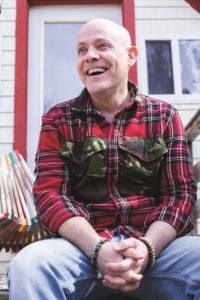
In the summer of 2020, he moved to Wellfleet with his wife and two children to escape the isolation that was so profound for city-dwellers. Soon, local materials began to find their way into his work. Here he has created a series of chairs as well as small wooden sculptures from shipping pallets sourced at the Mid-Cape lumber yard and with color references ranging from rose hips to swim lessons at Gull Pond.
Educated in industrial design at the Rhode Island School of Design, D’Aponte worked early in his career for a defense contractor, designing clothing for soldiers. Whereas that process relied on careful execution of planned designs, he now enjoys the freedom of open-ended exploration.
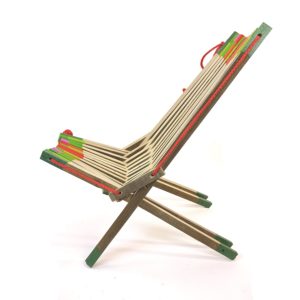
The transition to Wellfleet, he says, allowed him to make new, more child-like observations, which he began sharpening on his walks around Wellfleet center. “I’d walk by Mid-Cape every day,” he says, “and see this stack of pallets that would grow and shrink.” He began researching and collecting them, he says, becoming “a pallet connoisseur.”
The remains of these pallets are neatly stacked in D’Aponte’s workshop. He explains the pallets’ markings, noting country of origin and the method of preservation — HT referring to heat treated, which is safe to use, as opposed to the toxic MB treated with the pesticide methyl bromide.
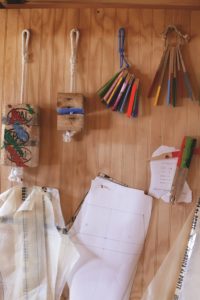
After a friend gave him a low, laid-back Kentucky stick chair, he started noticing that the foldable wooden chairs were enjoying a renewal online. “I started messing around seeing if I could make one out of pallets,” D’Aponte says. As he was working on the technical challenges of creating the chair, D’Aponte began playing with color.
The small sculptures — something he hadn’t done since he was a student at LaGuardia High School in New York City — took shape from offcuts that he dipped in acrylic paint as “color experiments.”
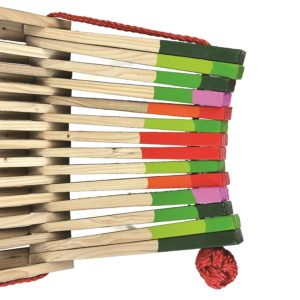
“I was taking tons of photos and spending more time in nature than ever before,” D’Aponte says. He started working with nature’s color palettes (a verbal pun he enjoys) from photos he had taken, digitally isolating colors from each picture, then finding matching exterior acrylic paint into which he would dip the ends of the wooden “sticks.” As the idea progressed, he assigned each chair a particular place.
In his chair called “Twilight at Duck Harbor,” the tips of each stick reference the deep blues of water and the fiery oranges of a summer sunset. In “Rosehips,” a range of greens mix with red and pink to create a rhythmic pattern of color set against the beige of the unpainted wood, a subtle reference to the sandy environs where rosehips grow. D’Aponte’s color is pure and bright, suggesting the optimism and delight of a summer day.

Each chair is held together by a piece of rope, another reference to their beachy, nautical context. “I’ve gotten to know a lot about ropes and knots,” he says, learning mostly from books he found at the Wellfleet Public Library.
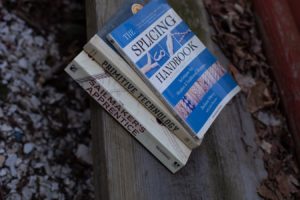
Although he initially purchased the rope for his chairs, he has since begun volunteering on the Center for Coastal Studies’ beach cleanups and trash sorting, which has yielded him a few coils of the “fishing detritus,” now hanging outside his woodshop. “It now becomes a new challenge of what to make with that,” D’Aponte notes.
D’Aponte’s small-scale sculptures traverse similar territory as his chairs yet without the functionality. In one piece, a split block of wood hangs from a rope, the inner surfaces illuminated with baby blue paint, giving vitality to something otherwise overlooked. “The sculptures get to be even more whimsical than the chairs,” he says. “The chairs have a loose itinerary.”
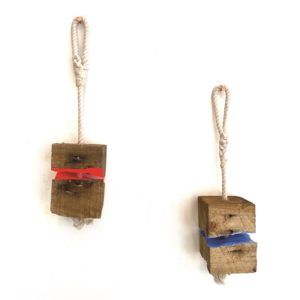
But he quickly tires of trying to establish distinctions between his art and design. “There’s so much specialization,” he says. “I don’t want to be a specialist. I want to be a generalist.” Under the eaves of his home, he keeps a studio of “soft goods” — clothing he makes by mixing and juxtaposing shirts with pockets from other shirts, or pants with cuffs from other pants.
“Every project is about making something from what we already have or that has untapped potential,” he says. “If you know where the garbage is from, it’s archaeology.”



